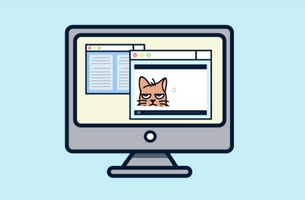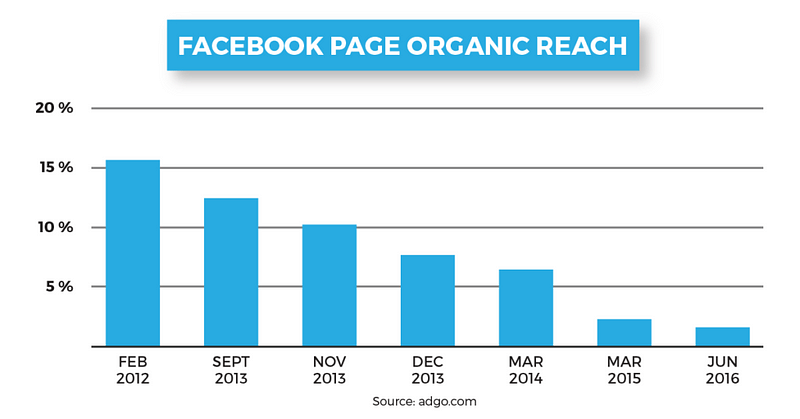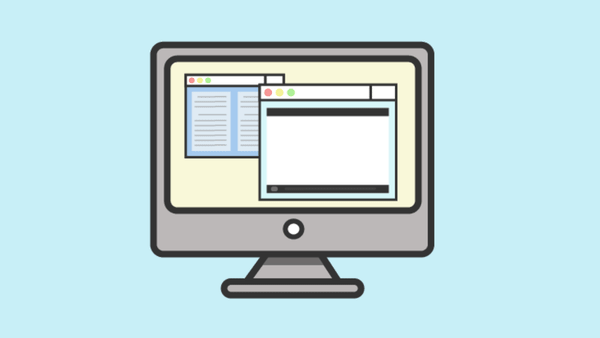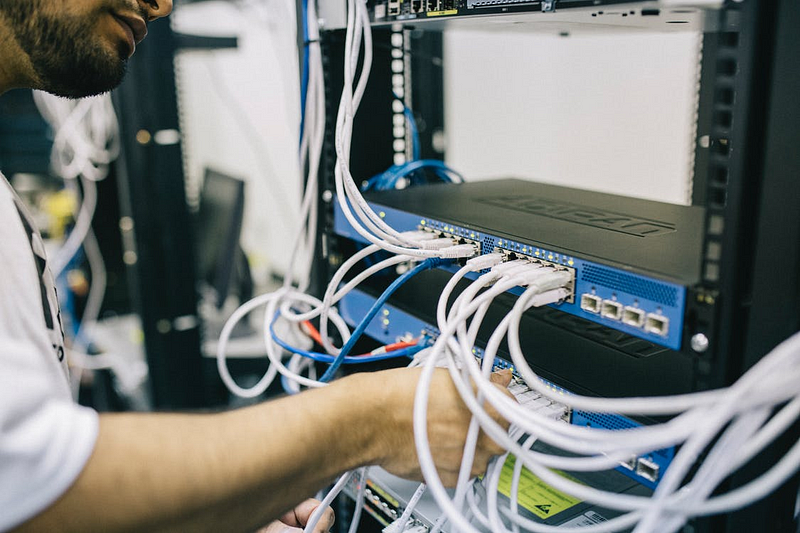
Is Clickbait Dead?

Earlier this month, Facebook announced yet another change to how it ranks content in the newsfeed. The bottom line? Facebook wants to encourage more personal connections between friends and family members.
Facebook is attempting to get back to its roots, but better. Whereas the social giant’s original mission statement was to “make the world more open and connected,” CEO Mark Zuckerberg announced last June that Facebook’s mission would be evolving “not just to connect the world but to bring the world closer together.”
The new mission statement is to: “Give people the power to build community and bring the world closer together.”
This latest move seeks to address two ongoing issues: declines in personal sharing and the polarising effects of echo-chambers generated by Facebook’s relatively recent status as a news portal.

Opinion by Caroline Desmond, Director of Media Strategy
1.) Decline in Personal Sharing
A little under two years ago, a report by a leading tech blog, The Information, revealed that fewer Facebook users were engaging in “original sharing,” or personal updates. There’s a great Fortune article explaining this further. Suffice to say, this trend is largely caused by the perception that Facebook is more of a public platform versus a private one. As Facebook began to distribute more professionally produced content, time spent on the platform increased, but the inside jokes and casual asides we used to post began to feel more out of place. This led to fewer personal connections and, according to recent research referenced by Facebook, a less fulfilling experience for users.
Specifically, in his Jan. 11th post, Zuckerberg referenced research conducted by Facebook that reveals “passively reading articles or watching videos — even if they’re entertaining or informative — may not be as good” for our well-being and that using social media to “connect with people we care about” can make us “feel more connected and less lonely, and that correlates with long-term measures of happiness and health.”
Zuckerberg elaborates that: “Recently we’ve gotten feedback from our community that public content — posts from businesses, brands and media — is crowding out the personal moments that lead us to connect more with each other.”
Whether you believe Facebook’s motivations are altruistic or not, one thing is likely — Facebook will probably see a drop in time spent as a result of reducing the prevalence of news and entertainment content in the feed. Less time spent means less opportunities for Facebook to serve up ads to users, and that means less revenue. So, it would seem that this decision may have other motivations beyond driving the bottom line after all.
2.) The Echo Chamber
The prevalence of news content on Facebook combined with the newsfeed algorithm prioritising content users are likely to engage with has reinforced ideological bubbles. On the one hand, users have seen more news content as it floods the feed. Simultaneously, Facebook has insulated those users from opinions they are less likely to agree with in an effort to serve up content more likely to resonate with individual users and get them to engage. Users will still continue to be somewhat insulated from opposing views even with the latest change to prioritise posts from friends and family. This will be the case assuming we connect with people of like-mind on social platforms. Thus, there is a high probability that news content shared by friends and family members we’re connected to on Facebook will still perpetuate the echo chamber effect to some degree. News content just won’t have the additional reinforcement of Facebook placing those news stories directly at the top of the feed.
Impact on Brands
Ad rankings on Facebook are not likely affected by this latest change to the newsfeed algorithm. This is so because brands already recognise they have to pay to be seen on Facebook; it’s unlikely there will be a mass influx of brands suddenly entering the Facebook ads marketplace because they just now realised they have to pay to play. Organic reach has been declining for years to almost nothing, so Facebook’s status as a pure paid platform for brands is nothing new.

This also isn’t the first time Facebook has prioritised posts from friends and family in the feed in recent past.
In June 2016, there was a similar change to Facebook’s algorithm.
The change had the most detrimental effect on publisher reach on Facebook causing organic publisher reach to plummet by ~42%. And if there were any brands still skating by on organic reach alone, the June 2016 algorithm update was probably the final incentive needed to invest in boosting posts. In fact, Facebook CPM’s increased by 171% in 2017 going from an average of $4.12 to $11.17. This most likely results from increased demand — more advertisers entering the market to buy ads on Facebook — despite flat supply (available impression volume remained relatively flat throughout 2017).

That said, it’s not likely we’ll see another substantial jump in rates this year. Furthermore, Facebook CPMs are still extremely competitive in light of what other mass reach channels charge — $8 Outdoor Advertising, $10 Radio, $15 Digital Sponsorships, $15 Print, $28 Broadcast.
There is a higher probability that Facebook will continue to filter out clickbait-style content in favor of more meaningful content as part of its long-term mission to emphasize quality impressions over quantity. As Recode reports, Facebook’s goal is to “encourage people to interact, which would theoretically help them walk away feeling less crummy.” To do this, Facebook will want to rank posts with higher relevance to users, more likely to deliver an engagement versus just a passive view. If anything, this encourages brands to up their creative game and could lead to a net positive effect on the quality of advertising in the Facebook feed.
5 New Year’s Resolutions For Digital Marketers
Words by Devon Brown, Performance Marketing Manager at North

New Year’s Resolutions are usually reserved for diet and fitness goals, but applying some targets to your professional life is never a bad idea. Below are 5 practical resolutions you can work toward in 2018.
Test More
As I reflect on the past year, some of my biggest accomplishments came out of testing. Ideating possibilities and following through with them is how we stretch, learn and grow. The most important knowledge when testing is not knowing what will and won’t work, but knowing when to stop the test because it’s not working, and when to double down because it is.
Learn To Move On Quickly
If you do a lot of testing, you’re going to fail. Not everything will work, and you may let poorer performing tactics go on longer than they should. Other times, you may find yourself in a position where no matter how much you optimize and tweak, the goals you set for yourself just aren’t attainable. Dwelling on these doesn’t help anyone. Acknowledge the failures, take the learnings, and move on quickly. More opportunities will come.
Make Voice Search A Focus
Voice search sauntered out of 2016 and charged into 2017, guns blazing. Now it’s here, in all its glory, changing everything. Search queries are changing, buying behavior is changing, and the way we uncover product reviews is changing. Whether you sell multi-million dollar cloud solutions or eco-friendly cartons of organic beans at farmers markets, voice search affects your business. Make peace with this fact and learn how to make it an asset, not another reason to be passed over.
Embrace Micro-Moments
That moment when it’s the last possible minute you need to fall asleep before your 8 am presentation, and you’re wide awake, mind racing.
That moment when you’re sitting on the couch, super comfy, lights dimmed, candles on, and you need to change the channel but the remote is nowhere to be found.
This is our new world. Micro-moments. Those little vortexes of time when there is an immediate problem in need of an immediate solution so all will be right with the world. In 2018, commit to identifying these, and see where it leads your marketing strategy. Be the product or service that removes the little struggles that are preventing your audience from being who they want to be in the moment.
Go Mobile
Take this one with caution: Download all the optimisation apps that are available to you on your phone. Yes, I know, it’s good to unplug completely, but sometimes at 11 PM on a Saturday an idea will pop into your head. And if you’re anything like me, you won’t rest until it’s done. Instead of reminding yourself to do it, or stressing about wondering whether the optimisations you did a few days ago took hold and the clock is ticking, check in on your phone, do what you need to do, and get back to your life. It helped me tremendously, but if it’s going to turn you into an insufferable workaholic, maybe pass on this one.
Have other resolutions for the new year? Let us know in the comments.
Advertising and Net Neutrality
Written by Izzy Kramer, Media Planner at North

A month ago net neutrality was all over the news as anticipation grew leading up to the Federal Communications Commission’s vote to keep or repeal net neutrality measures set in 2015. The final 3–2 vote on December 14th repealed net neutrality. Then, as with all hot news stories, it faded into the background as more popular stories made headlines. However, this is not a topic that should easily be forgotten or discarded. Especially as the first steps in the fight to reinstate net neutrality started gaining major headway this week — more on that later. First, let us recap.
What is net neutrality? Net neutrality is the idea that the internet is a common commodity, like a household utility such as water or electricity. It legally binds Internet Service Providers (or ISPs) to “provide access to all websites and data equally, regardless of their content”.
According to New York Times columnist Ken Roose, who was a guest on NYT’s podcast The Daily, there are two schools of thought on this issue: the “dumb pipe” and the “smart pipe” opinions.
The dumb pipe opinion is that the internet and how it is accessed should be like running water in your home. You turn on the faucet and water comes out; you open your computer browser and internet connection comes out. The pipes that carry the internet should not prioritize certain types of content or data.
The smart pipe opinion is that Internet Service Providers have the right to determine how content on the internet is administered because they built the pipes that get high-speed internet to their customers.
For the most part, ISPs, such as Verizon and Comcast, are proponents of the smart pipe opinion, because they want control over the service they provide. It is internet content creators and distributors, such as Netflix, Google, and Facebook, that support the dumb pipe theory. They want to continue to use the pipes to deliver their content and rely on ISPs to do so fairly and equally.
It gets even stickier when you consider ISPs also fit into the category of content creators and distributors. For example, Comcast owns NBCUniversal Media who, in a joint venture with Fox Entertainment Group, ABC, and Time Warner, developed the VOD streaming service Hulu. Although it was agreed upon by Comcast and the FCC that neither Comcast nor NBCUniversal would influence Hulu’s operations, who isn’t to say Comcast, now with more control, won’t prioritize Hulu by slowing down the speed or limiting customer access to Hulu’s competitors, such as Netflix and Amazon Prime Video? Food for thought.

Now think about this in terms of advertising. How much advertising is digitally based and depends on the internet to broadcast messaging? Personally speaking, I know the media plans I put together are heavily digital, if not completely digital campaigns. So, the internet without net neutrality could greatly influence digital advertising, the ad industry, and the brands they work for.
According to Mediapost.com’s columnist Elizabeth Bleser, “on the most basic level, brands [could] end up paying more to have their content/ads published online. If Internet Service Providers like Comcast and Verizon begin to charge website ‘tolls’ for being able to deliver the websites’ experience, those costs will ultimately be passed onto brands through increased cost-per-thousand (CPM)” impression rates. Also, knowing that digital ads can be influenced by ISPs — whether that be reduced or faster speeds on the sites they are present on — could ultimately influence what publishers make it onto a media plan. Furthermore, campaign target audiences vary in what Internet Service Providers they use, and knowing who uses what internet service would influence where you reach your audience. If we begin to see the effects of the internet without net neutrality, will media planners begin looking up ISPs along with basic demo and psychographics when researching their target audiences? Funny to think about now but it may determine what publishers are on a plan.
Of course, this is all speculative consequences and outcomes. With any dark cloud, there is a silver lining. For example, Ad Age reported that the internet without net neutrality “could be a perfect opportunity to pair programmatic creative with programmatic media buying. There will be hundreds of different rate plans targeted at specific cohorts. There will also be opportunities to create new consumer and brand experiences that include “unlimited” bandwidth or “free” bandwidth offers . . . it will change the media distribution landscape dramatically. It will be the perfect place for new creative ad units and offers such as trusted, needed, or content companions.” It gives smart and savvy marketers an opportunity to shine.
With all this said, no major effects have been noted due to the repeal of net neutrality, but some aren’t waiting until that happens. As of this week, 21 states have filed suit to challenge the FCC’s repeal. Big name digital corporations such as Twitter, Facebook, and Google have also publicly declared their support to reinstate net neutrality through legislative means. Nevertheless, it would take a majority vote in both the House and Senate, and any legislative measures to restore net neutrality would still be subject to a presidential veto. These are the beginning steps of a long journey for those fighting to get the power out of ISPs hands. Despite this, we push ahead.










